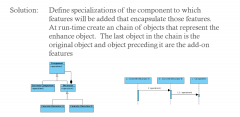![]()
![]()
![]()
Use LEFT and RIGHT arrow keys to navigate between flashcards;
Use UP and DOWN arrow keys to flip the card;
H to show hint;
A reads text to speech;
10 Cards in this Set
- Front
- Back
|
Strategy Pattern |
Intent: Allow algorithms to be selected at runtime, by defining a family of algorithms, encapsulating each algorithm, and making the algorithms interchangeable within that family Context: Implementation of a family of algorithms Problem: This pattern addresses situations where there are multiple ways of doing the same kind of thing, but with different kinds of input, output, or runtime characteristics and the choice of which way to do it has to be made at runtime |
|
|
Strategy Pattern |

|
|
|
Strategy Pattern |
Consequences: - In the strategy hierarchy, inheritance can help factor out common functionality of the algorithms, especially if combined with the Template Method pattern. -Encapsulating the algorithm in separate Strategy classes lets you vary the algorithm independently of its context, making it easier to switch, understand, and extend. -Strategies can eliminate conditional statements. |
|
|
Observer Pattern |
Intent: Simplify dependencies between objects when state changes are a primary concern. Context: There are multiple possible contexts, but the most common is graphical user interfaces, where multiple displays need to show state information about the same objects. However, in general, the context could be any system where state changes need to be monitored by multiple components. Problem: The system includes a objects of certain classes (i.e., subjects) whose state changes must known by objects of other classes (i.e., observers). The subjects and the observers may be organized into sub-classes. |
|
|
Observer Pattern |

|
|
|
Observer Pattern |
Consequences: -Lower coupling between subjects and observers - Support a multicast-style of communication, where the sender (subject) does not need to know about or depend on the specific receivers (concrete observers) -Observers can be completely independent of each other, even though they may deal with the same subject object |
|
|
Decorator Pattern |
Intent: Attach any combination of additional responsibilities to an object at run time Context: Any system where combinations of features are possible and there is a potential for an explosion in the number of sub classes Problem: The actors of a system need to add or remove features to an object dynamically |
|
|
Decorator Pattern |

|
|
|
Decorator Pattern |
Consequences: -More flexibility that static inheritance -Avoid explosion of sub-classes -More testable than one bloated class -Lots of little objects linked in a delegation chain that represent one real-world object -As the components interface becomes more complex, the complexity of the |
|
|
Simply Factory Idiom |
Intent: Reduce coupling with concrete constructors Context: Any situation where a system needs to create instances from a hierarchy of classes Problem: A component needs to create a specific kind of object from a class hierarchy, called the product class hierarchy, but the choice of which concrete product subclass to instantiate has to be made at runtime. |

